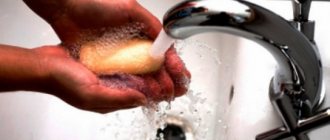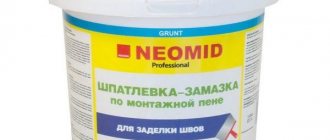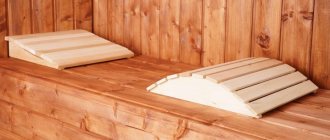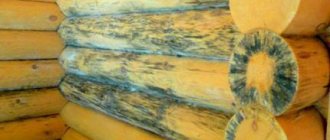Polyurethane foam sealant (popularly called polyurethane foam) is a professional product, the use of which significantly increases the sound and heat insulation properties of the treated surface and helps securely fasten individual structural elements.
After application, the airy foam turns into a dense mass in a matter of minutes, which is very difficult to clean.
Only with the right products is it possible to solve the problem of dried sealant stains. Read the article about how to clean dried polyurethane foam from various surfaces.
How to remove using improvised means?
Regardless of which product is chosen to remove traces of polyurethane foam, the surface cleaning process takes place in the following sequence:
Using a sharp construction blade, cut off the frozen mass from the surface as much as possible. It is important to ensure that the blade only touches the polyurethane layer- The remaining very thin layer of polyurethane foam sealant is treated with the selected composition. First of all, use the most gentle available means.
- After fifteen to twenty minutes, the softened layer is cleaned off with the hard side of a dishwashing sponge.
Instead of a sponge, you can use a piece of rubber or a stationery eraser.
How to wash off old sealant with Dimexide?
A popular pharmaceutical drug with anti-inflammatory action, Dimexide, has established itself as an effective remedy in the fight against hardened polyurethane foam.
It is enough to cover the stain with a cloth, generously moistened with Dimexide and leave for thirty minutes. During this time, the frozen polymer particles will dissolve, and all that remains is to wipe the stain with a damp cloth.
Do not apply Dimexide to a foam sponge (the pharmaceutical product corrodes the foam). You can work with Dimexide only with rubber gloves (there is a high risk of chemical burns to the skin).
The video will show you how to remove hardened polyurethane foam with Dimexide:
Sunflower oil
Vegetable oil can gently and delicately remove hardened foam from the skin. The dirt is moistened with lukewarm oil (heated in a water bath), left for half an hour , after which it is easily removed with a soft, damp sponge.
A preliminary procedure of steaming your hands in hot water will speed up the process of removing polyurethane foam sealant.
Table vinegar
Vinegar will help clean plastic and metal surfaces from dried foam. The dirt is generously moistened with a solution of vinegar and water (mixed in a 1:1 ratio) and left to soak for twenty to thirty minutes. Afterwards, the dirt can be easily removed with the hard side of a dishwashing sponge.
Pumice
A proven product - pumice - will help you clean your hands from frozen foam.
Dirty hands are immersed in warm water for thirty minutes, after which, after lubricating the skin with a thick layer of cream, they begin to scrub off the frozen foam with a pumice stone.
You need to act slowly and carefully . After the last piece of pumice is removed, hands are rinsed with warm water and lubricated with a nourishing protective cream.
How to change the cylinder without clogging the gun
Gun with cylinder
Often inexperienced guys, when they change foam cylinders on a pistol, dirty everything around: the gun itself, the cylinder, hands, clothes... After all, the cylinders are under pressure. But there is an easy way to avoid this, do everything clean, and be known as a neat master. So, you've run out of gas. You vent the remainder somewhere in the trash so that the residual pressure in the cylinder is minimal. Then turn the gun over with the cylinder facing down and unscrew the empty cylinder while continuing to pull the trigger. This way, you and your gun will not be sprayed with foam; all the gas will go through the spout. Now screw the balloon in the same way, holding the gun upside down. At some point you will hear “pfff”, that’s it, at that moment the valve worked and foam went into the gun. Everything around is clean.
You don’t have to thank us, just like us from the bottom of your heart and subscribe to the latest materials from our brave team of finishing craftsmen. See you again, friends!
How to remove with special chemicals?
In a situation where the first stage of cleaning hardened polyurethane foam with improvised means was unsuccessful, it makes sense to use more aggressive, special cleaning compounds. TOP 3 most effective professional tools:
Cleaner Cosmofen 5
Leader among special professional compounds. In one treatment it will clean any surfaces from stubborn dirt:
- glue,
- oils,
- polyurethane foam.
In addition, Cosmofen 5 smoothes treated surfaces and eliminates scratches and abrasions. After treatment, it leaves a protective layer on the surface that is resistant to ultraviolet rays.
Cosmofen 5 cleaner does not burn and does not have a strong, pronounced chemical odor. The average cost is 430 rubles. (cylinder 1 l).
Mastertex Premium
Designed to remove particles of hardened polyurethane sealant from any surfaces, incl. cylinder valves and construction guns. Simultaneously cleans, degreases and disinfects surfaces.
The method of application is simple: shake the can and spray onto contaminated areas. After ten minutes, the remaining polyurethane foam sealant is removed with a cloth. The average cost is 290 rubles. (500 ml bottle).
ATOLL
Designed to quickly clean the surface from residues of hardened polyurethane foam. Ideal for cleaning:
- working tools and clothing,
- window and door frames.
After use it does not leave marks or streaks (does not react with PVC and other plastics). It is enough to spray the product onto the frozen foam, leave for ten minutes, and then wipe with a damp sponge. The average cost is 150 rubles. (500 ml bottle).
To ensure that the product does not completely lose its appearance after cleaning with special compounds, the selected product must be tested in advance on an inconspicuous, small area of the contaminated surface.
You can work with professional chemical compounds only in a well-ventilated area , wearing gloves and a respirator. Spray cleaning aerosols away from heating devices and open flames.
How to wipe off dried polyurethane foam: 6 professional cleaners
Until recently, the question of how to clean polyurethane foam at home if it has completely dried out would have been perplexing. But progress does not stand still. And manufacturers present to the consumer new, effective chemicals that can actually destroy polyurethane foam. The choice of compositions is quite wide, so to choose the right foam cleaner, use the table below.
Table - Professional foam cleaners and their characteristics
| Name | Characteristic | Taboo |
| PENO-OFF | — Removes fresh and old foam; — cleans working tools (gun); - used for window frames, glass, doors, plastic | — Prohibited on painted surfaces, interior parts coated with varnish; — strictly contraindicated when working with hot surfaces |
| Mellerud | — Removes foam from wooden, glass, ceramic, plastic and stone surfaces; — cleanses from dried and fresh lumps; - used for windows, window sills, doors, blinds, walls, floors | — Dangerous for skin, eyes and mucous membranes; - not intended for varnished parts |
| TYTAN PROFESSIONAL | — Removes frozen foam; — dissolves drops in literally two minutes; — cleans wood, stone, glass, ceramics, clothing, furniture upholstery, PVC, steel; - used to remove foam from hands | — Allowed for all surfaces, considered safe |
| Platina Cleaner | — Cleans the gun from foam residues; — eliminates fresh and dried material; - removes oiliness and paint | — Prohibited for use on surfaces coated with paint or varnish |
| "Purex" | — Eliminates hardened foam to almost a millimeter; — used on vertical surfaces due to its paste-like composition; — cleans any surfaces, and even PVC profiles; - leaves no scratches | — Unsafe for the human body |
| HOBBY | — Softens and eliminates dried foam; - has frost resistance; – effectively cleans almost all surfaces | — Not intended for working with plastic and plexiglass; — has explosive ability when heated above 50 ºС |
Do not use cleaning products near open flames. Almost all chemicals are explosive. And pay close attention to where the drops of cleaners end up. Some of them can very quickly corrode varnish coatings, discolor or destroy the laminate.
What not to do and why?
There are several restrictions that you should remember before starting the process of removing hardened polyurethane foam.
Thus, dried polyurethane foam sealant should never be washed off under pressure of water. The result of such actions will be even more hardened pollution (foam expands under the influence of water).
Do not scrape the frozen layer from the surface with a knife or rub it with abrasive powders (scratches and abrasions that remain in place of the dried foam cannot be removed).
Do not apply solvents to varnished or painted surfaces. The result of such cleaning is whitish, worn-out gray hair, which is impossible to get rid of.
Acetone-based compounds should not be used to clean iron doors. By reacting with the surface, the polyurethane foam penetrates even more deeply into the thickness of the metal. Subsequently, under direct sunlight, particles of sealant appear on the iron surface in the form of yellow, indelible stains.
How to clean fresh foam from clothes?
First of all, you should immediately separate it from the fabric using a spatula, spatula or any sharp object. Be careful not to damage the fabric or dawdle; the longer you wait, the more difficult it will be to clean the clothing later. Next, clean the fabric with any product that is also applicable for cleaning dried foam, which we described in detail below.
Important! Before using any products, you need to test them on the wrong side of the fabric on which you are going to use them.
Adviсe
A layer of hardened foam on the glass will help remove the sharp blade . Carefully, trying not to press too hard on the glass, layer by layer of the frozen sealant is simply cut off from the smooth glass surface.
If foam gets on your clothes, you need to wait until it dries and only then can you start cleaning. By smearing fresh marks on clothes, you can achieve only one thing - the sealant will be absorbed into the fibers of the fabric, and it will no longer be possible to remove it.
Freezing is a good way to remove cured construction foam. Place contaminated clothing in the freezer for at least twelve hours. Frosted sealant loses its density, as a result of which it is easy to clean off with a stiff brush or scraper.
The easiest way to remove traces of foam from a wooden surface is to sand it . The sealant is cut off as much as possible with a sharp knife, the remaining part is sanded off. The cleaned surface is re-coated with varnish or paint.
You will find useful tips and recommendations on how to remove polyurethane foam from various surfaces and objects here.
Compositions suitable for removing foam
Solvents for specific purposes
Almost every major manufacturer of polyurethane foam also produces an accompanying product for cleaning construction guns, which is also successfully used to clean surfaces and clothing from polyurethane foam that has fallen on it. When purchasing foam from a certain company, it is recommended to immediately buy a solvent from the same manufacturer, since it will definitely become an effective means for cleaning tools and various surfaces.
Another factor to pay attention to is the effect of the cleaner, as some formulations are designed to remove foam that has just hit the skin or objects, while others are designed for long-standing stains. In addition, when purchasing a solution, you should study its characteristics, since some of them negatively affect certain materials that foam can get on.
Several examples of cleaners widely available on sale will be presented in the table:
| Illustration | Brief description of the compositions |
| “IsoFoam R621” is a domestic product specially designed for removing fresh stains from polyurethane foam, removing it from skin, clothing, and also washing mounting guns. This is the most affordable product that should be on hand when renovation work is being done in a house or apartment, as it will help clean the surface not only of foam, but also of paint or varnish. This cleaner is suitable for all types of foam. | |
| "Cosmofen" is another cleaning composition manufactured by a foam manufacturing company. However, it should immediately be noted that this solvent is produced in four versions, each of which has its own number - “Cosmofen” No. 5, 10, 20 and 60. Only composition No. 5 ; other options are used for other purposes. If “Cosmofen 5” , then before applying it to the surface, it is necessary to test the resistance of the material to this composition. "Cosmofen 5" is suitable for removing only fresh stains. It is applied to the contaminated surface, wait a few minutes, then wipe off with a dry cloth, running it in one direction. It is not recommended to use this product in rooms with high humidity, as its effectiveness is reduced. "Cosmofen 5" effectively removes foam stains from plastic surfaces and linoleum. | |
| “Macroflex Cleaner” is a cleaning product that is highly effective in dissolving fresh polyurethane foam and cleaning contaminated surfaces from it, as well as for washing the mounting gun immediately after completion of work. This composition is not effective for dried material. “Macroflex Cleaner” is also used to wash a clean gun, which is recommended every two to three months to maintain it in working condition. The product can damage some materials - polished and painted surfaces, plastic parts, and some fabrics. Therefore, when carrying out work, it is necessary to protect clean, uncontaminated areas from the negative effects of the solvent. | |
| "ULTIMA Professional" is a universal cleaner for cleaning various surfaces and clothing, as well as tools from uncured polyurethane foam. In addition, the composition is used for applying it to glass and metal before using polyurethane foam or sealants - this greatly facilitates the removal of contaminants after work. ULTIMA Professional is a fast-acting product, but it does not melt or leave marks on plastic materials. | |
| Penosil Premium Cured PU-Foam Remover is a cleaner designed to remove hardened polyurethane foam from various surfaces and clothing items. However, it must be used extremely carefully, since it is a very aggressive solvent that affects not only the foam, but also the paint and varnish applied to certain objects. Therefore, it is recommended to carry out a test first by applying the composition to a small area of the item being cleaned, so as not to completely damage its surface. |
To use one of the presented compositions or similar means for cleaning surfaces, you need to remove the protective cap and install the spray head that comes with the cleaner (the same as on most standard aerosol cans). By pressing this head, it is necessary to treat the contaminated areas with a solvent, leave them for a certain time (indicated by the manufacturer on the packaging), and then wipe off the “floating” polyurethane foam with a napkin.
First, the gun adapter is cleaned using a spray head. The head is then removed, the can is screwed onto the adapter, and solvent is forced through the gun to remove any remaining foam from the inside.
If it is necessary to clean the mounting gun after work, instead of foam, a bottle of cleaner is screwed into its adapter. Then the lever is pressed several times so that the flushing agent passes through the gun tube, releasing the remaining foam until a clean solvent appears.
Craftsmen always try to simplify a task and make it cheaper to complete. See, for example, how you can make your own and how to then use a home-made device for better washing of a spray foam gun.
Video: Washing a spray foam gun using a homemade device
It makes sense to recall a few key safety rules for working with professional products sold in sealed containers. Not only are solvents flammable. They are also in a pressure cylinder, so the following rules should be observed:
This fully applies not only to the washes under consideration, but also to all pressure cylinders in general. Here, for example, is what can happen if a cylinder of polyurethane foam transported in a car overheats...
- Do not leave the cylinder in direct sunlight or in places where it can heat up to a temperature of 45-50 degrees. Moreover, the danger is posed not only by full cylinders, but also by those that, in the opinion of the master, are already empty and used.
- It is strictly forbidden to try to open any container, even an empty one, or to throw it into a fire.
- It is unacceptable to work with flammable solvents near open fire sources, or to smoke near or in a room where any operations with such compositions are performed.
- Work should be done in a respirator, safety glasses and gloves - this will reduce the likelihood of washable foam residues getting on the surface of the skin or eyes, and unsafe solvent fumes getting into the respiratory mucosa.
- The room where such construction work is carried out must be well ventilated. In the absence of effective ventilation, a concentration of volatile solvent vapors that is dangerous from the point of view of both toxicity and fire may accumulate.
Naturally, when carrying out such work, it is necessary to ensure that children do not enter the room. And any construction aerosol cans should be kept completely out of reach of curious children's hands.
Common solvents for painting work
In addition to professional products specifically designed for cleaning foam, other solvents known to all builders are used for similar purposes - white spirit, kerosene, gasoline, turpentine and acetone. These compounds are also flammable liquids, so when working with them, you must fully comply with all the safety rules listed above.
White spirit is both a solvent and a cleaner.
- White spirit is a composition that is used to dissolve paints and varnishes, as well as to remove paints and varnishes from hands and clothing. Using white spirit, you can dissolve thickened drying oil, bitumen compounds, alkyd, enamel and oil paints, glypthal and pentaphthalic varnishes. It is prohibited to add white spirit to solutions containing water, water-soluble alkali, or acids.
White spirit will also help with fresh stains of polyurethane foam; it will also help remove old stains from some surfaces.
Other solvents based on petroleum products - gasoline or kerosene - can have approximately the same effect as white spirit.
To remove foam from fabric, acetone or solvents based on it are often successfully used.
- Acetone is also a very aggressive solvent for many paints and varnishes, and is especially nitro-based. Quite often, acetone helps to dissolve foam. However, acetone is quite an aggressive agent, so it can destroy the texture of the material, leaving a faded stain, for example, on fabric, linoleum or laminate. Therefore, this substance should be used very carefully.
Turpentine is one of the most famous means for cleaning surfaces from paints. It also helps with removing remnants of polyurethane foam.
- Turpentine is a solvent known for a long time, used to remove various stains, including those left on surfaces from polyurethane foam. These types of solvents are not too aggressive, so they will not damage or discolor the surface or fabric, or burn the skin. The products may leave greasy stains on the fabric, but they can be washed off with detergents.
Folk remedies
There are other compounds that are not, in fact, solvents and are not directly intended for removing foam. However, their ability to clean surfaces was experimentally identified.
- Such products include vegetable oil, the inexpensive and over-the-counter drug "dimexide", alcohol mixed with salt and diluted with water, soda in combination with the above-mentioned solvents.
- There are also some completely unusual recommendations. For example, such that foam that gets on clothes can be easily removed by placing the fabric in the freezer. However, this must be done extremely carefully so that the polyurethane does not smear on its surface.
The fabric on which the foam has fallen should be placed in the freezer, being careful not to disturb the size and shape of the stain or to smear it.
- Another option that works great in some cases is to remove the foam completely mechanically, without using any compounds. That is, first, most of the mass is removed, and traces of it are carefully cut off with a blade. However, this method is only suitable for hard and smooth surfaces.
Now that we have considered the main means of getting rid of polyurethane foam, it is necessary to consider which surfaces and what compositions can be applied to in order to obtain the desired effect, as well as where contaminants can be removed mechanically.
If the foam gets in the wrong place
In this case, acetone will work for you. It will dissolve material that has not yet hardened before our eyes . However, he can only help you until the composition dries. After hardening, only chemical and mechanical means will help you.
1. Use a knife, scraper or wire brush. Frozen pieces, for example from a wooden door, are first cut off, and after that the surface is cleaned with sandpaper.
2. Specially designed cleaners are used. Examples include “Purex”, “Russian Professional”, “Platina Cleaner”, “PENO-OFF” and others.
Ways to use such compositions:
The container of liquid should be shaken and sprayed onto the contaminated area. After 10 minutes, the dissolved residues are removed, and the surface is wiped clean with a rag.
Please pay attention! During use, be aware of the contact points of the cleaning solution, as... Along with the hardened material, you can also remove varnish, paint or other coatings, for example, from laminate flooring. It is also strictly prohibited to use the compositions near open fire!
Dried tracks
After completing part of the construction work, there is no time left to check if there are any traces of the materials used anywhere. As a result, people end up with dried foam in the most unexpected places. It is the most difficult to wash, but it is best to remove it from some surfaces in its dried form.
As a rule, the main part of the dried piece is cut off first. Then special means are used (for example, Dimexide), with which the remaining traces are wiped off. Sometimes they simply use the power of sunlight, because... The rays destroy the structure of frozen foam pieces, but this takes a lot of time.
Special products for removing glass and other materials
The range of many manufacturers of polyurethane foam also includes cleaners, this is especially true for large enterprises (Tytan, Makroflex, Soudal, TECHNONICOL). As an example, here are several options:
Kudo Foam Remover is a hardened foam remover designed to remove composition from metal, plastic and other surfaces that have a non-porous structure;
Soudal foam cleaner 0.1 l. Photo by Leroy Merlin
Soudal PU Remover - cleaner of hard foam from non-porous surfaces: metal, glass, ceramics, many laminated elements, etc., a spatula and brush are provided with the product;
Polynor Cleaner is a cleaner for removing foam and non-hardening Polynor insulation from window frames, glass and window sills.
Prevention
As you know, a problem is easier to prevent than to solve. Therefore, try to protect yourself, your clothes and furniture in your apartment as much as possible when working with foam. What should be done:
- Be sure to wear gloves to prevent the substance from getting on your hands.
- Cover your head with a cap or other head covering. This will protect your hair not only from foam, but also from dust and construction debris.
- Wear old clothes that you can safely get dirty. It should be comfortable and completely cover the body to prevent further rubbing of foam from the skin.
- You can buy special disposable overalls for construction work to protect yourself and your clothes as much as possible. You can also use a disposable raincoat for this purpose.
- When renovating, it doesn’t hurt to always cover floors and pieces of furniture if they have not been removed. To do this, you can use old bedspreads, newspapers or plastic wrap.
- Try to work carefully and do everything according to the instructions.
Using these simple techniques, you can remove foam from jackets, clothes, furniture and other things. And do not forget to test the selected product on the inside of the product before using it, because it is unknown how your fabric will behave in this case.
Share on social media networks:
Mounting gun
After pouring foam into all the necessary places, particles of it may remain in the gun, which will soon dry out. The sooner a person notices its traces, the easier it will be to clean the construction equipment.
How to clean the gun:
- Check to see if the foam has dried. If it is still soft, then the gun needs to be washed with Isofoam R cleaner.
- When it has time to harden, you need to either clean off the residue with a screwdriver or use a solvent (OPPA or PENOSIL).
After cleaning, the gun will work again. The main thing is to clean carefully, especially if you use a screwdriver and other items for mechanical cleaning.
Fresh tracks
The easiest way to remove fresh foam from most surfaces. While it has not had time to harden, it is very easy to assemble. The main thing is to do this with gloves to avoid sticking to your hands. The best option would be to use a plastic object that will be able to collect all the residue without scratching the surface. The final touch to cleaning uncured foam is to use special detergents with a soft cloth.
It is advisable to choose one of the following (choose by surface type):
- Acetone;
- Isofoam R621;
- Cosmofen;
- Macroflex.
You can avoid damage to the surface on which the foam has fallen by first checking its reaction to the cleaning agent. To do this, simply apply a small amount of the substance that will be used for removal to a very small, inconspicuous area.











